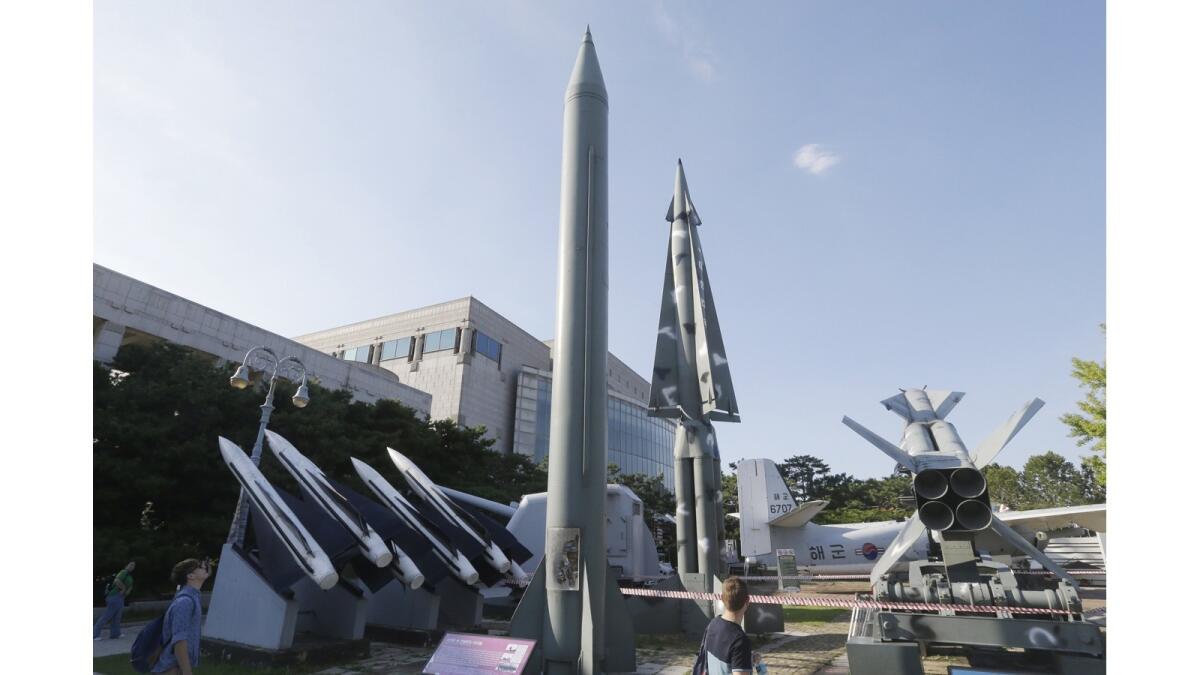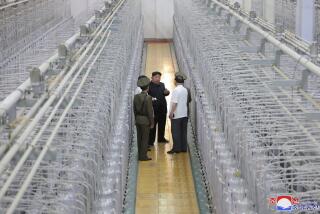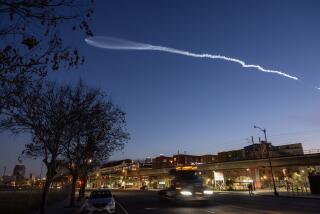U.S. keeping a close eye on North Korean satellite launch site

Models of North and South Korean missiles are displayed outside a war museum in Seoul. Officials say there are no signs a North Korean missile launch is imminent.
Reporting from WASHINGTON — U.S. intelligence analysts are scrutinizing a newly modified North Korean satellite launch facility but see no imminent threat despite the reclusive government’s latest threats of nuclear attack against the United States.
U.S. officials say North Korean crews have upgraded the Sohae Satellite Launching Station in recent months by building new rail tunnels to move equipment and new buildings where a long-range ballistic missile could be assembled.
“The goal is to prevent us from seeing what they’re doing,” said a U.S. official, who was not authorized to speak publicly on the intelligence assessments. “Stealth has been central to each facet of the new design.”
The launch facility is about two hours’ drive from Yongbyon, North Korea’s major facility for producing nuclear bomb fuel. State media announced Tuesday that “normal operation” had restarted at Yongbyon, which had been partly deactivated under a 2007 international agreement.
U.S. intelligence officials have built a tabletop model of Sohae based on satellite imagery. They say the gantry tower appears more than 200 feet tall and could accommodate a larger rocket or missile than the country has launched in the past.
“The technology they use on their rockets is nearly the same as what’s used on an” intercontinental ballistic missile, the U.S. official said. “That’s what has our attention.”
On Tuesday, North Korea threatened to use nuclear weapons at “any time” against the U.S. because of its “reckless hostile policy,” bellicose language the government in Pyongyang has used often before.
U.S. analysts don’t believe the threat is serious, and South Korea’s Defense Ministry said it had not detected preparations for a missile launch.
But U.S. officials are concerned that Kim Jong Un’s government has made progress toward building a smaller nuclear warhead and a missile that could carry it outside the region. The country is believed to have 10 nuclear warheads.
In December 2012, North Korea launched a three-stage rocket that placed a crude satellite into orbit. Two months later, it conducted a third underground nuclear blast test.
Pyongyang previously has timed nuclear tests and missile launches to coincide with major political anniversaries. This year, Oct. 10 marks the 70th anniversary of the founding of the ruling party, and U.S. intelligence analysts are watching for a possible missile test that day.
The country’s largest missiles could reach South Korea or Japan, but are unable to hit Guam, Hawaii or the U.S. mainland, according to U.S. estimates. More powerful missiles are under development but haven’t been tested.
“North Korea is the greatest threat that I face in the Pacific,” Adm. Harry B. Harris Jr., head of U.S. military forces in the Asia-Pacific region, told the Senate Armed Services Committee on Thursday. “You have a leader in North Korea who has nuclear weapons and is seeking the means to militarize them and deliver them intercontinentally, and that causes me great concern.”
Adm. William Gortney, head of North American Aerospace Defense Command and U.S. Northern Command, said in April that he was concerned about Pyongyang’s missile capabilities but that U.S. missile defense capabilities are adequate.
“Should one [missile] get airborne and come at us, I’m confident that we’ll be able to knock it down,” he said at a Pentagon news briefing.
The Obama administration said any use of ballistic missile technology would violate United Nations Security Council resolutions aimed at curbing the country’s missile launches.
“We continue to call on North Korea to refrain from irresponsible provocations that aggravate regional tensions, and instead focus on fulfilling its international obligations and commitments,” State Department spokesman John Kirby said Tuesday.
Jim Walsh, a security expert at Massachusetts Institute of Technology’s Security Studies Program, said if North Korea tests another missile, it would be mostly for a domestic audience.
“These sorts of tests are a way for Kim to build legitimacy — the crisis that it creates makes it easier for him to govern and lift people up behind him,” Walsh said.
The impoverished country is facing a severe drought, and Kim may be looking to rally and distract a starving and frustrated population with a show of military force, he said.
“This is a kind of provocation that is pretty low risk” for Kim, Walsh said.
More to Read
Sign up for Essential California
The most important California stories and recommendations in your inbox every morning.
You may occasionally receive promotional content from the Los Angeles Times.












